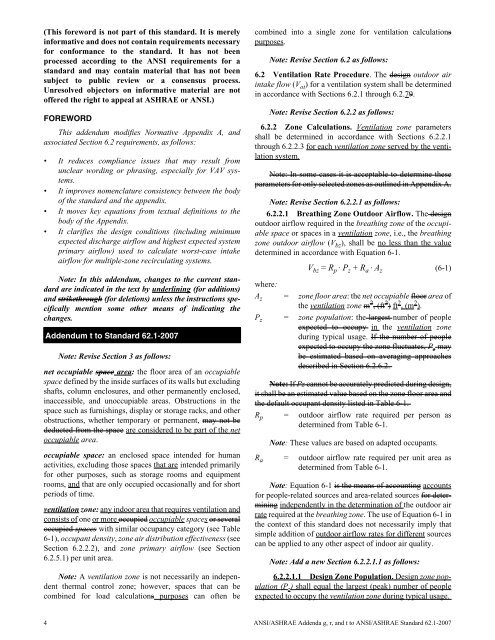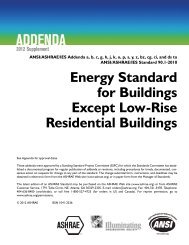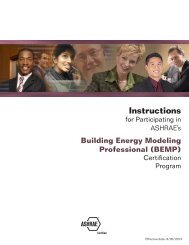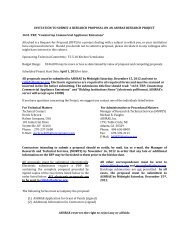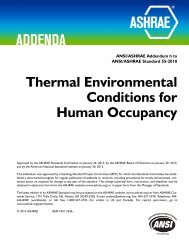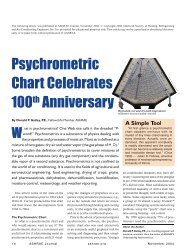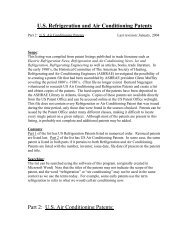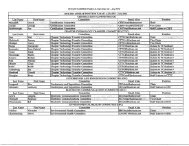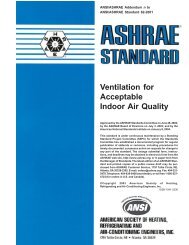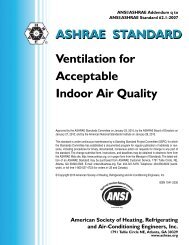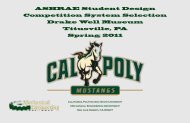ANSI/ASHRAE Standard 62.1-2007 ASHRAE STANDARD Ventilation
ANSI/ASHRAE Standard 62.1-2007 ASHRAE STANDARD Ventilation
ANSI/ASHRAE Standard 62.1-2007 ASHRAE STANDARD Ventilation
You also want an ePaper? Increase the reach of your titles
YUMPU automatically turns print PDFs into web optimized ePapers that Google loves.
(This foreword is not part of this standard. It is merely<br />
informative and does not contain requirements necessary<br />
for conformance to the standard. It has not been<br />
processed according to the <strong>ANSI</strong> requirements for a<br />
standard and may contain material that has not been<br />
subject to public review or a consensus process.<br />
Unresolved objectors on informative material are not<br />
offered the right to appeal at <strong>ASHRAE</strong> or <strong>ANSI</strong>.)<br />
FOREWORD<br />
This addendum modifies Normative Appendix A, and<br />
associated Section 6.2 requirements, as follows:<br />
It reduces compliance issues that may result from<br />
unclear wording or phrasing, especially for VAV systems.<br />
It improves nomenclature consistency between the body<br />
of the standard and the appendix.<br />
It moves key equations from textual definitions to the<br />
body of the Appendix.<br />
It clarifies the design conditions (including minimum<br />
expected discharge airflow and highest expected system<br />
primary airflow) used to calculate worst-case intake<br />
airflow for multiple-zone recirculating systems.<br />
Note: In this addendum, changes to the current standard<br />
are indicated in the text by underlining (for additions)<br />
and strikethrough (for deletions) unless the instructions specifically<br />
mention some other means of indicating the<br />
changes.<br />
Addendum t to <strong>Standard</strong> <strong>62.1</strong>-<strong>2007</strong><br />
Note: Revise Section 3 as follows:<br />
net occupiable space area: the floor area of an occupiable<br />
space defined by the inside surfaces of its walls but excluding<br />
shafts, column enclosures, and other permanently enclosed,<br />
inaccessible, and unoccupiable areas. Obstructions in the<br />
space such as furnishings, display or storage racks, and other<br />
obstructions, whether temporary or permanent, may not be<br />
deducted from the space are considered to be part of the net<br />
occupiable area.<br />
occupiable space: an enclosed space intended for human<br />
activities, excluding those spaces that are intended primarily<br />
for other purposes, such as storage rooms and equipment<br />
rooms, and that are only occupied occasionally and for short<br />
periods of time.<br />
ventilation zone: any indoor area that requires ventilation and<br />
consists of one or more occupied occupiable spaces or several<br />
occupied spaces with similar occupancy category (see Table<br />
6-1), occupant density, zone air distribution effectiveness (see<br />
Section 6.2.2.2), and zone primary airflow (see Section<br />
6.2.5.1) per unit area.<br />
Note: A ventilation zone is not necessarily an independent<br />
thermal control zone; however, spaces that can be<br />
combined for load calculations purposes can often be<br />
combined into a single zone for ventilation calculations<br />
purposes.<br />
Note: Revise Section 6.2 as follows:<br />
6.2 <strong>Ventilation</strong> Rate Procedure. The design outdoor air<br />
intake flow (V ot ) for a ventilation system shall be determined<br />
in accordance with Sections 6.2.1 through 6.2.79.<br />
Note: Revise Section 6.2.2 as follows:<br />
6.2.2 Zone Calculations. <strong>Ventilation</strong> zone parameters<br />
shall be determined in accordance with Sections 6.2.2.1<br />
through 6.2.2.3 for each ventilation zone served by the ventilation<br />
system.<br />
Note: In some cases it is acceptable to determine these<br />
parameters for only selected zones as outlined in Appendix A.<br />
Note: Revise Section 6.2.2.1 as follows:<br />
6.2.2.1 Breathing Zone Outdoor Airflow. The design<br />
outdoor airflow required in the breathing zone of the occupiable<br />
space or spaces in a ventilation zone, i.e., the breathing<br />
zone outdoor airflow (V bz ), shall be no less than the value<br />
determined in accordance with Equation 6-1.<br />
Vbz = Rp · Pz + Ra · Az (6-1)<br />
where:<br />
Az = zone floor area: the net occupiable floor area of<br />
the ventilation zone m2 , (ft2 ) ft2 ,(m2 ).<br />
Pz = zone population: the largest number of people<br />
expected to occupy in the ventilation zone<br />
during typical usage. If the number of people<br />
expected to occupy the zone fluctuates, Pz may<br />
be estimated based on averaging approaches<br />
described in Section 6.2.6.2.<br />
Note: If Pz cannot be accurately predicted during design,<br />
it shall be an estimated value based on the zone floor area and<br />
the default occupant density listed in Table 6-1.<br />
R p = outdoor airflow rate required per person as<br />
determined from Table 6-1.<br />
Note: These values are based on adapted occupants.<br />
R a = outdoor airflow rate required per unit area as<br />
determined from Table 6-1.<br />
Note: Equation 6-1 is the means of accounting accounts<br />
for people-related sources and area-related sources for determining<br />
independently in the determination of the outdoor air<br />
rate required at the breathing zone. The use of Equation 6-1 in<br />
the context of this standard does not necessarily imply that<br />
simple addition of outdoor airflow rates for different sources<br />
can be applied to any other aspect of indoor air quality.<br />
Note: Add a new Section 6.2.2.1.1 as follows:<br />
6.2.2.1.1 Design Zone Population. Design zone population<br />
(Pz ) shall equal the largest (peak) number of people<br />
expected to occupy the ventilation zone during typical usage.<br />
4 <strong>ANSI</strong>/<strong>ASHRAE</strong> Addenda g, r, and t to <strong>ANSI</strong>/<strong>ASHRAE</strong> <strong>Standard</strong> <strong>62.1</strong>-<strong>2007</strong>


